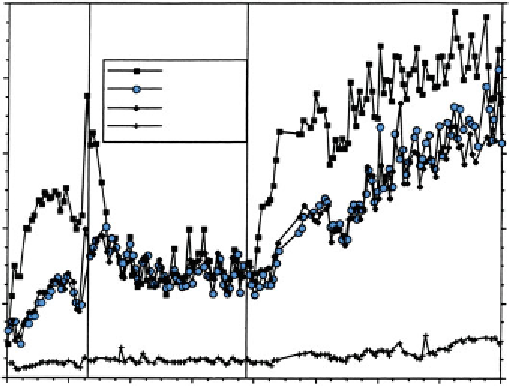Biomedical Engineering Reference
In-Depth Information
1.0
Lactate
Phenol
Lactate
2SSE1
0.8
2SSE2
2SSE3
Extract
0.6
0.4
0.2
0.0
0
100
200
300
400
500
600
700
800
Time (hrs)
Figure 8.5. TCE concentration history during the second season of testing with the bioaugmenta-
tion of mutant PR1
301
of Burkholderia cepacia G4 that expressed TOM constitutively (fromMcCarty
et al.,
1998b
). Periods of lactate to phenol and back to lactate additions are shown.
demonstrated that bioaugmentation was successful in achieving rapid utilization of phenol to
limit its spread during
in situ
biostimulation. In previous studies where indigenous phenol
utilizers were stimulated, it took over 2 weeks before phenol was reduced below the detection
limit.
After 390 h, the substrate was switched from phenol back to lactate. As shown in Figure
8.5
,
TCE concentrations gradually increased to the injection concentration, indicating treatment was
no longer effective. DO concentrations suggest lactate was being consumed and residual DO
levels remained above 8 mg/L, which was an ample amount to maintain TCE cometabolism.
Analysis of the presence of PR1
301
using molecular methods indicated that its detection in the
test zone was rapidly lost. It was detected in the first monitoring well for the first 4 days, and
then was only detected two times during the phenol injection and was not detected in the later
period of lactate injection.
In the third season of testing, the PR1
301
was grown under more controlled conditions in the
laboratory, the amount injected was doubled, and lactate was continuously fed. Initially TCE
concentrations decreased, showing 80-90% removal, but as time progressed, TCE concentra-
tions increased toward the injection concentration, indicating that TCE transformation ceased.
After about 830 h, the feed was switched from lactate to phenol (6 mg/L). TCE concentration
decreased and about 50% removal was achieved.
In general, the results showed good TCE removal early in the three studies, but TCE
transformation could not be sustained when lactate was fed as a substrate. The researchers
suggested two possibilities for the loss in TCE transformation: (1) predation of the introduced
population; or (2) an inability of the PR1
301
strain to compete for the added lactate (although
both processes may have contributed). The researchers concluded that in order for TCE
cometabolism to be successful, methods are needed to avoid the competition for lactate.
The molecular probes described by Matheson et al. (
1997
) were used to detect
B. cepacia
and the mutant strain PR1
301
in the field tests. In the first season of testing, PR1
301
was detected
at the first monitoring well
(1 m from the injection well) during the first 6 days of

Search WWH ::

Custom Search